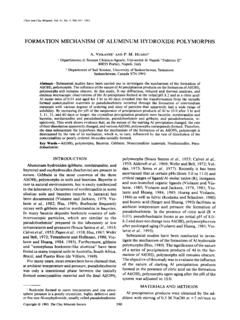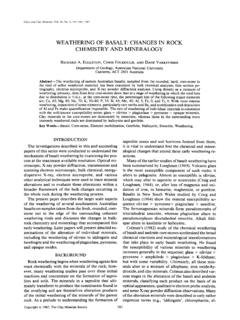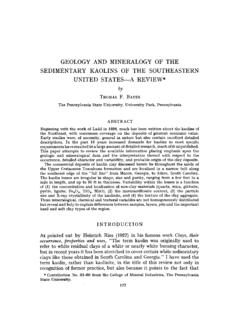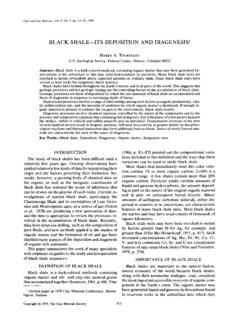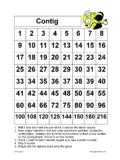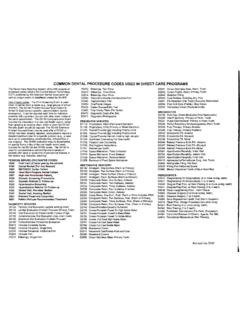Transcription of Clays and Clay Minerals, Vol. 45, No. 1, 85-91, 1997.
1 Clays and clay Minerals, , No. 1, 85-91, 1997. S U R F A C E C H A R G E PROPERTIES OF KAOLINITE. BRIAN K. SCHROTH AND GARRISON SPOSITO. Division of Ecosystem Sciences, Hilgard Hall #3110, University of California, Berkeley, California 94720-3110. Abstract -The surface charge components of 2 Georgia kaolinites of differing degrees of crystallinity (KGa-1 and KGa-2) were determined using procedures based on charge balance concepts. Permanent structural charge density (tr0) was determined by measuring the surface excess of Cs, which is highly selective to permanent charge sites. The values of cr0 determined were -~ and --- mmol kg -~ for kaolinites KGa-1 and KGa-2, respectively.
2 The net proton surface charge density (trn) was determined as a function of pH by potentiometric titration in mol dm -3 LiC1. Correction from apparent to absolute values of crn was made by accounting for A1 release during dissolution, background ion adsorption and charge balance. Lithium and C1 adsorption accounted for the remainder of the surface charge components. Changes in surface charge properties with time were measured after mixing times of 1, 3 and 15 h. the latter representing "'equilibrium". Time-dependenl behavior is believed to be caused by mineral dissolution followed by readsorption or precipitation of A1 on the mineral surface. Both the point of zero net charge ( ) and the point of zero net proton charge ( ) changed with mixing time, generally increasing.
3 The "'equilibrium" , values were approximately for KGa-1 and for KGa-2, whereas the corresponding , values were about and The , results were in good agreement with previous studies, but the values of , were higher than most other values reported for specimen kaolinite. Key Words----Dissolution, Kaolinite. Point of Zero Charge, Potentiometric Titration, Proton Surface Charge, Structural Charge, Surface Charge, Surface Chemistry. INTRODUCTION vary f r o m to above 7. S o m e of the disagreement can be attributed to differences in sample preparation K n o w l e d g e of the surface charge characteristics of and to the use of different models to interpret data, but kaolinite is essential to deciphering the m e c h a n i s m s of the breadth o f the distribution o f pH values in Table its reactions with xenobiotic c o m p o u n d s (Haderlein 1 is m u c h larger than what is typical for specimen and Schwarzenbach 1993) and mapping the pathways oxide minerals.
4 E x a m p l e s are = -+ and o f its weathering reactions in sediments and soils = - for "y-A1203, based on data com- (Stumm 1992; C h o r o v e r and Sposito 1995b). Promi- piled by Goldberg et al. (1996), nent among these characteristics are the density of sur- Recently C h o r o v e r and Sposito (1993, 1995a), face charge created by isomorphic substitutions in a building on w o r k by Charlet and Sposito (1987) and mineral structure (denoted tr0) and that created by pro- A n d e r s o n and Sposito (1991, 1992), have developed ton adsorption and desorption reactions with a contig- and applied an experimental m e t h o d o l o g y for measur- uous aqueous solution (denoted ~ ).
5 The sign of ~r0 is ing surface charge components and testing the result- always negative for kaolinite, arising either directly ing data for consistency with the law o f surface charge from A I ( I I I ) substitution for Si(IV) in the tetrahedral balance: sheet of the mineral (Bolland et al. 1976), or indirectly tr 0 + tyn + Aq = 0 [1]. f r o m isomorphic substitutions in 2:1 layer type clay where Aq is the net adsorbed ion surface charge den- mineral inclusions (Lim et al. 1980; Jepson 1984; K i m sity, the difference of adsorbed cation and anion et al. 1996). The sign o f tr H varies with aqueous so- charge, exclusive o f that contributed by adsorbed pro- lution pH, taking on a zero value at the tons and hydroxide ions (Sposito 1992).
6 In this paper, (Sposito 1992) and b e c o m i n g negative at higher pH. we present the first application of this new method- values. ology to specimen kaolinites of varying crystallinity. Significant variability exists a m o n g published ex- The primary objectives of our research were to deter- perimental studies o f the surface charge behavior of mine the surface charge characteristics o f specimen specimen kaolinites. Its points of zero charge (Sposito kaolinite u n a m b i g u o u s l y and to ascertain the nominal 1992) offer a prototypical example, as shown in Table effects of degree of crystallinity. 1. The data in Table 1 are not intended to be compre- hensive, but only to illustrate the wide range o f pH MATERIALS AND METHODS.
7 Values in the published literature. Isoelectric points Stock Suspensions ( ; p H value at which the electrophoretic mobility Samples ( kg) o f 2 specimen kaolinites, K G a - i is zero) range f r o m to , while , values and KGa-2, described as " w e l l c r y s t a l l i z e d " and Copyright 9 1997, The clay Minerals Society 85. 86 Schroth and Sposito Clays and clay Minerals Table 1. Points of zero charger reported for kaolinite. Cs was twice-extracted with 1 rh ammonium acetate Value Reference (NH4 OAc). The LiCI and NH4 OAc solutions were an- alyzed for Cs by atomic emission spectroscopy (Perkin Isoelectric point , Parks (1967). ( ) Ferris and Jepson (1975) Elmer Model 2380).
8 Permanent structural charge den- Carroll-Webb and Wal- sity, ~r0, was calculated as minus the difference be- ther (1988) tween moles Cs in the NH4 OAc extract and moles Cs 3 Braggs et al. (1994) in the entrained LiC1 solution, per kg of dry kaolinite. Point of zero net <4 Schindler et al. (1987). proton charge Motta and Miranda Proton Titration and Ion Adsorption Measurements ( ) (1989). Xie and Walther (1992) Samples of the stock suspension containing 350 mg Zhou and Gunter (1992) of dry kaolinite were placed in 35-mL centrifuge Wieland and Stumm tubes. To each tube, 6a LiC1 containing a prede- (1992) termined amount of rta HC1 or LiOH was added Braggs et al. (1994).
9 Sverjensky (1994) so that the total mass of solution was 35 g. A given LiCI/HC1 (or LiCI/LiOH) electrolyte solution mixed Point of zero net Ferris and Jepson (1975). charge ( ) <4 Bolland et al. (1976) with kaolinite represents a single point in a discontin- 4 Zhou and Gunter (1992) uous proton titration. Each mixture was replicated once, with a kaolinite-free blank prepared for each ~ = pH value at which electrophoretic mobility = 0. replicate. An Orion model 8102BN combination pH. = pH value at which ~H = 0. = pH value at which Aq = 0. electrode was calibrated by Gran titration (Gran 1952;. Chorover and Sposito 1993), so that electrode output could be converted directly to hydrogen ion concen- "poorly crystallized" by van Olphen and Fripiat tration ([H+]).
10 Proton concentration instead of activity (1979), were obtained from the Source Clays Reposi- was determined in order to avoid the use of activity- tory of the clay Minerals Society. The samples were coefficient models (Chorover and Sposito 1995a). suspended repeatedly in l mol dm -3 NaC1/HC1 or The samples were mixed by slow rotation (about 7. LiC1/HC1 solution at pH 3. After centrifugation of the revolutions per rain) for periods of 1, 3 or 14-16 h. suspension at 10,000 RCF, the supernatant solution Following centrifugation, the supernatant solution was was discarded and replaced with fresh solution. After carefully transferred to 60-mL high density polyeth- the supernatant solution pH value had dropped to 3, ylene (HDPE) bottles.

